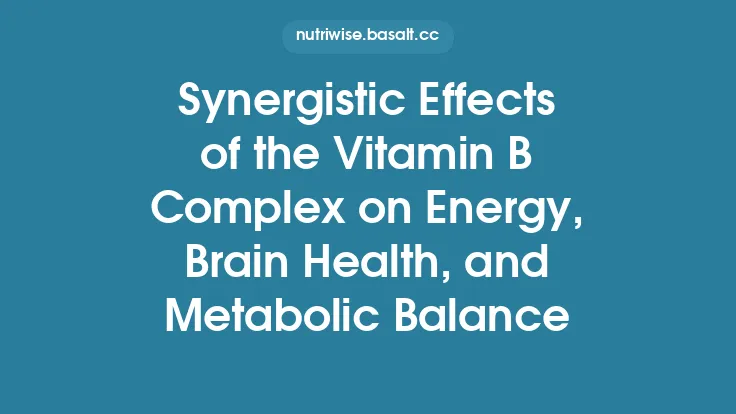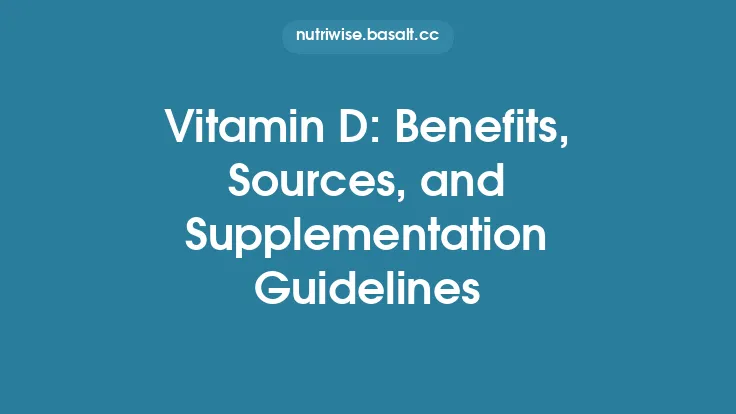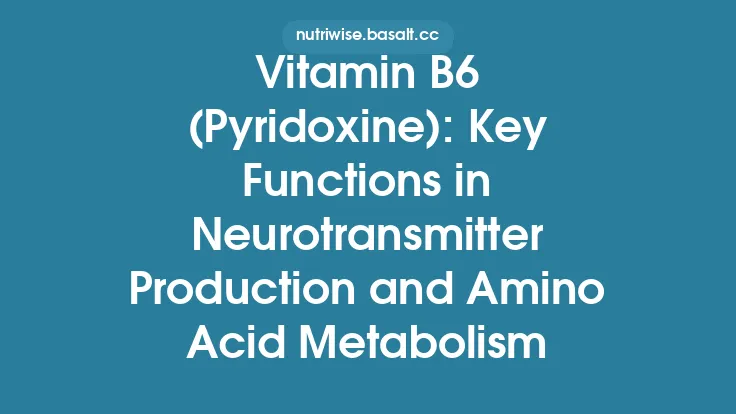Vitamin B complex refers to the eight water‑soluble vitamins that work together as co‑enzymes in virtually every cellular process that generates energy, synthesizes DNA, and maintains nervous system health. Because the body cannot store most of these nutrients in large reserves, a regular intake through diet—or, when necessary, supplementation—is essential for optimal metabolic function. This article delves into the distinct roles of each B vitamin, the biochemical interdependence that defines the “complex,” and the practical considerations that should guide anyone thinking about adding a B‑complex supplement to their routine.
Overview of the B Vitamin Family
The B‑vitamin family comprises thiamine (B1), riboflavin (B2), niacin (B3), pantothenic acid (B5), pyridoxine (B6), biotin (B7), folate (B9), and cobalamin (B12). Although they share a common classification, each vitamin possesses a unique chemical structure and a set of enzymatic partners. Collectively, they support:
- Energy metabolism – converting carbohydrates, fats, and proteins into adenosine triphosphate (ATP).
- Redox balance – acting as electron carriers in oxidative‑reduction reactions.
- One‑carbon metabolism – transferring methyl groups for DNA synthesis and repair.
- Neurotransmitter synthesis – producing serotonin, dopamine, GABA, and norepinephrine.
- Lipid and amino‑acid metabolism – facilitating fatty‑acid oxidation and amino‑acid transamination.
Because they are water‑soluble, excess amounts are typically excreted in urine, which reduces the risk of chronic toxicity but also means that regular intake is required.
Individual B Vitamins: Key Functions and Physiological Roles
| Vitamin | Primary Co‑enzyme(s) | Core Biological Functions |
|---|---|---|
| Thiamine (B1) | Thiamine pyrophosphate (TPP) | • Decarboxylation of α‑keto acids (e.g., pyruvate → acetyl‑CoA) <br>• Pentose‑phosphate pathway (ribose‑5‑phosphate production) |
| Riboflavin (B2) | Flavin mononucleotide (FMN) & flavin adenine dinucleotide (FAD) | • Redox reactions in the electron transport chain <br>• Fatty‑acid β‑oxidation <br>• Conversion of vitamin B6 to its active form |
| Niacin (B3) | Nicotinamide adenine dinucleotide (NAD⁺/NADP⁺) | • Central role in glycolysis, TCA cycle, and oxidative phosphorylation <br>• DNA repair (PARP enzymes) |
| Pantothenic Acid (B5) | Coenzyme A (CoA) & acyl‑carrier protein (ACP) | • Synthesis of fatty acids, cholesterol, and steroid hormones <br>• Acetyl‑CoA formation, a hub for energy metabolism |
| Pyridoxine (B6) | Pyridoxal‑5′‑phosphate (PLP) | • Amino‑acid transamination, decarboxylation, and glycogenolysis <br>• Synthesis of neurotransmitters (serotonin, dopamine, GABA) |
| Biotin (B7) | Biotinyl‑5′‑adenylate (covalently attached to carboxylases) | • Carboxylation reactions in gluconeogenesis, fatty‑acid synthesis, and amino‑acid catabolism |
| Folate (B9) | Tetrahydrofolate (THF) derivatives | • One‑carbon transfers for purine/pyrimidine synthesis <br>• Methylation cycles (homocysteine → methionine) |
| Cobalamin (B12) | Methylcobalamin & adenosylcobalamin | • Methyl group transfer (methionine synthase) <br>• Rearrangement of methylmalonyl‑CoA to succinyl‑CoA (odd‑chain fatty‑acid metabolism) |
Interdependence and Synergy Within the B Complex
The B vitamins rarely act in isolation. For example, the conversion of dietary tryptophan to niacin requires B6 as a co‑factor, while the regeneration of active folate depends on B2 and B3. Moreover, the methylation cycle hinges on a coordinated hand‑off between folate, B12, and B6. Disruption of one member can create a functional bottleneck that impairs the entire network, a phenomenon known as “B‑vitamin antagonism.” Understanding this synergy is crucial when formulating a supplement: a balanced ratio helps maintain metabolic flux and prevents the accumulation of intermediates that could be harmful (e.g., homocysteine).
Absorption, Transport, and Metabolism of B Vitamins
| Vitamin | Absorption Site | Transport Mechanism | Key Metabolic Notes |
|---|---|---|---|
| B1 | Duodenum & jejunum (active Na⁺‑dependent transporter) | Phosphorylated to TPP in the liver; circulates bound to albumin | Requires magnesium for activation |
| B2 | Proximal small intestine (carrier‑mediated) | Converted to FMN/FAD in the liver; bound to plasma proteins | Light‑sensitive; excess excreted in urine |
| B3 | Small intestine (passive diffusion) | Nicotinamide and nicotinic acid absorbed; hepatic conversion to NAD⁺/NADP⁺ | High doses can cause flushing (niacin) |
| B5 | Small intestine (passive diffusion) | Esterified to CoA in the cytosol; widely distributed | No known specific transport protein |
| B6 | Jejunum (active transport via B⁰AT1) | PLP formed in the liver; bound to albumin | Requires pyridoxal kinase; excess excreted |
| B7 | Small intestine (carrier‑mediated) | Biotinylated carboxylases in mitochondria & cytosol | Gut microbiota produce small amounts |
| B9 | Duodenum & jejunum (carrier‑mediated, reduced folate carrier) | Reduced to THF in enterocytes; transported as 5‑methyltetrahydrofolate | Folate polyglutamates require deconjugation |
| B12 | Ileum (intrinsic factor‑mediated endocytosis) | Binds transcobalamin II for cellular uptake | Requires adequate gastric acid and intrinsic factor; stored in liver for years |
Dietary Sources and Bioavailability Considerations
While whole foods remain the most reliable source of B vitamins, the bioavailability of each can vary dramatically:
- Animal‑derived foods (liver, meat, eggs, dairy) provide highly bioavailable B12, B6, and niacin.
- Plant foods (leafy greens, legumes, whole grains, nuts) are rich in folate, B1, B2, and B5, but the folate is often in polyglutamate form, which must be deconjugated for absorption.
- Fermented foods (nutritional yeast, tempeh) can contain significant amounts of B2, B3, and B12 (the latter only if fortified).
- Cooking and processing can degrade heat‑sensitive vitamins (e.g., thiamine, folate). Steaming or microwaving for short periods preserves more B‑vitamin content than boiling.
When evaluating dietary adequacy, consider both the quantity and the matrix in which the vitamin is delivered, as food‑bound forms often have higher absorption efficiency than isolated synthetic forms.
Common Deficiency Patterns and At‑Risk Populations
| Vitamin | Typical Deficiency Signs | Populations at Higher Risk |
|---|---|---|
| B1 | Beriberi (wet: edema, heart failure; dry: neuropathy) | Chronic alcoholism, malabsorption, high‑carb diets |
| B2 | Cheilosis, glossitis, seborrheic dermatitis | Elderly, those on long‑term antibiotics |
| B3 | Pellagra (dermatitis, diarrhea, dementia) | Carcinoid syndrome, isoniazid therapy |
| B5 | Rare; may present as fatigue, numbness | Severe malnutrition, extensive burns |
| B6 | Peripheral neuropathy, microcytic anemia | Renal disease, oral contraceptive users |
| B7 | Dermatitis, alopecia, conjunctivitis | Pregnant women, infants on parenteral nutrition |
| B9 | Megaloblastic anemia, neural‑tube defects in fetus | Women of childbearing age, vegans |
| B12 | Pernicious anemia, subacute combined degeneration | Older adults, vegans, gastric surgery patients |
Because many deficiency symptoms overlap (e.g., dermatitis, neuropathy), clinicians often assess the entire B‑complex profile rather than isolated markers.
Safety, Upper Limits, and Potential Toxicity
The water‑soluble nature of B vitamins generally confers a low risk of chronic toxicity, yet certain forms can cause adverse effects at supraphysiologic doses:
- Niacin (nicotinic acid) – >35 mg/day may induce flushing, hepatotoxicity, and hyperuricemia.
- Pyridoxine (B6) – >100 mg/day for prolonged periods can lead to sensory neuropathy.
- Folate – Excessive folic acid (>1 mg/day) may mask B12 deficiency, potentially worsening neurologic outcomes.
- Biotin – High doses (>10 mg/day) can interfere with certain immunoassays, leading to erroneous lab results.
The Institute of Medicine (now the National Academy of Medicine) has established tolerable upper intake levels (ULs) for several B vitamins; adherence to these limits is advisable, especially when multiple fortified foods and supplements are consumed concurrently.
Forms of B Complex Supplements: Capsules, Tablets, Sublingual, Liquid, and Food‑Fortified Options
| Form | Advantages | Limitations |
|---|---|---|
| Standard tablets/capsules | Stable, cost‑effective, easy to dose | May contain binders or fillers; slower dissolution |
| Enteric‑coated tablets | Protects acid‑labile vitamins (e.g., B12) from gastric degradation | Delayed release; may reduce absorption if coating fails |
| Sublingual lozenges | Bypasses first‑pass metabolism; rapid plasma rise for B12 and B6 | Limited dose capacity; taste issues |
| Liquid drops/emulsions | Useful for individuals with dysphagia; can be mixed into beverages | Higher risk of oxidation; requires careful storage |
| Food‑fortified products (e.g., breakfast cereals) | Integrated into daily diet; often includes a balanced B‑complex ratio | May contain added sugars or sodium; bioavailability can vary |
When selecting a product, consider the specific B vitamins that require enhanced delivery. For instance, methylcobalamin (a bioactive B12 form) is often preferred over cyanocobalamin for individuals with impaired conversion pathways.
Stability, Storage, and Shelf‑Life Issues
- Light and heat degrade thiamine, riboflavin, and folate. Packaging in opaque, airtight containers mitigates loss.
- Moisture accelerates hydrolysis of B5 and B6. Desiccants are commonly included in bottle designs.
- pH influences stability: acidic environments favor niacin stability, whereas alkaline conditions can degrade biotin.
- Shelf‑life for most B‑complex tablets ranges from 2–3 years if stored at ≤25 °C and <60 % relative humidity. Liquid formulations typically have shorter stability windows (12–18 months) and may require refrigeration after opening.
Timing, Dosage, and Interaction with Medications or Other Nutrients
- Timing – B vitamins are best taken with meals containing some carbohydrate or protein, which stimulates insulin release and enhances cellular uptake.
- Dosage – For most adults, the Recommended Dietary Allowance (RDA) falls between 1.1–2.4 mg/day for B1, 1.1–1.3 mg/day for B2, 14–16 mg/day for B3 (as niacin equivalents), 5 mg/day for B5, 1.3–1.7 mg/day for B6, 30 µg/day for B7, 400 µg DFE (dietary folate equivalents) for folate, and 2.4 µg/day for B12. Supplements often provide 2–3× the RDA to ensure adequate tissue saturation, especially in at‑risk groups.
- Drug interactions –
- Metformin can reduce B12 absorption; supplementation may be warranted after 3–5 years of therapy.
- Proton‑pump inhibitors and H₂ blockers lower gastric acidity, impairing B12 release from food.
- Isoniazid interferes with pyridoxine metabolism; co‑administration of B6 (10–50 mg/day) is standard prophylaxis.
- Anticonvulsants (e.g., phenytoin) increase folate turnover, potentially necessitating higher folate intake.
- Nutrient interactions – High doses of B6 can antagonize the activity of B2-dependent enzymes; excessive folic acid may obscure B12 deficiency. Balanced ratios within a B‑complex formulation help mitigate these effects.
Special Considerations for Specific Life Stages and Health Conditions
- Pregnancy & lactation – Folate (400–800 µg DFE) and B12 (2.6–2.8 µg) requirements rise to support fetal neural tube closure and infant development. A methyl‑folate form may be advantageous for women with MTHFR polymorphisms.
- Elderly – Diminished gastric acid production and intrinsic factor secretion increase the risk of B12 deficiency; sublingual or injectable forms may be more effective.
- Athletes – Intense training elevates B‑vitamin turnover, particularly B1, B2, and B6, due to increased carbohydrate metabolism and protein turnover. Targeted supplementation (e.g., 100 mg B1, 10 mg B2, 25 mg B6) can support performance and recovery.
- Individuals with gastrointestinal disorders (celiac disease, Crohn’s disease, bariatric surgery) often experience malabsorption of multiple B vitamins; a comprehensive B‑complex supplement, possibly combined with a probiotic that produces biotin, may be indicated.
Evaluating the Need for Supplementation: When to Use a B Complex
- Dietary assessment – Identify gaps in food intake (e.g., low animal‑product consumption, restrictive vegan diets).
- Clinical indicators – Look for signs of deficiency (neuropathy, anemia, dermatitis) and confirm with laboratory testing (serum B12, plasma folate, erythrocyte transketolase activity for B1).
- Medication review – Determine if current prescriptions interfere with B‑vitamin metabolism.
- Lifestyle factors – Consider alcohol use, smoking, high‑intensity exercise, or chronic stress, all of which can increase B‑vitamin turnover.
If two or more of these criteria are met, a well‑formulated B‑complex supplement—ideally providing the vitamins in their bioactive or readily convertible forms—can be a prudent addition.
Practical Guidance for Incorporating B Complex into a Balanced Regimen
- Start low, go slow – Begin with a product delivering 100 % of the RDA for each vitamin; monitor tolerance before increasing the dose.
- Pair with food – Take the supplement with a balanced meal containing complex carbohydrates and protein to maximize absorption.
- Monitor biomarkers – Re‑check serum B12, folate, and homocysteine after 3–6 months of supplementation, especially in high‑risk groups.
- Rotate forms if needed – Some individuals experience gastrointestinal upset with high‑dose niacin; switching to niacinamide (a non‑flushing form) can alleviate symptoms while preserving NAD⁺ synthesis.
- Stay within ULs – Avoid “megadose” regimens unless prescribed for a specific medical condition (e.g., high‑dose B6 for certain seizure disorders).
By respecting the intricate biochemistry of the B‑vitamin family, acknowledging individual variability in absorption and metabolism, and selecting a supplement that aligns with personal health status and lifestyle, consumers can harness the full spectrum of benefits that a balanced B‑complex offers—enhanced energy production, robust nervous‑system function, and support for DNA synthesis and repair—without unnecessary risk.





